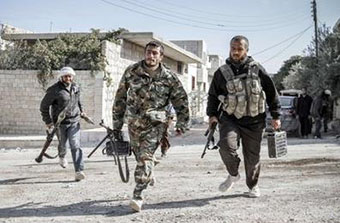
U.S. Forces to Join Ground Fight in Syria
| published January 16, 2015 |
By Thursday Review staff
The Pentagon has announced that the United States will send approximately 400 troops to Syria to assist in on-the-ground efforts to turn the tide of battle against ISIS, the Islamic State in Iraq and Syria (also sometimes called ISIL).
The 400 American personnel would be the first boots on the ground in a long war which began last year, and which saw the Islamic militants extend their territorial control over a vast swath of geography stretching from northern Syria near the border with Turkey, deep into Iraq, and to within about 30 miles of Baghdad. ISIS also took control of border checkpoints between Iraq and Jordan, and pushed south toward Saudi Arabia.
These 400-plus troops would be carefully selected, the Pentagon said, and may undergo specialized training in either Turkey or Saudi Arabia. The detachment may also include additional troops from those same countries, as well as from Qatar.
Though the 400 American troops will represent only a tiny fraction of the overall number of indigenous forces now fighting ISIS in various parts of Syria and Iraq, the insertion of U.S. infantry into the war zone establishes a significant—though tentative—shift in U.S. policy toward the conflict. Starting last summer, the U.S. and a dozen other countries began an air campaign to defang and destroy ISIS. Many military analysts have questioned whether the air campaign alone--which consists of targeted air strikes by both fighter jets, stealth bombers and drones--would be enough to degrade ISIS and slow its advance. Though ISIS's forward advance has been mostly halted, it continues to extend it effective control over much of the area under it now occupies, which includes a large part of northern Iraq.
The White House has said that the U.S. troops are part of a long-term strategy to degrade and destroy ISIS, and bring stability to a region now in its fourth year of civil war and lawlessness. Used mostly for training purposes, according to Pentagon spokespersons, the American troops will also concentrate on recruitment and intelligence-gathering and sharing. U.S. troops will also work toward forging an integrated, unified command for all forces now fighting ISIS.
The Pentagon hopes that the American advisory presence will spur a more efficient form of recruitment for the free armies, with a short-term goal of about 5,000 new local recruits, and a long-term goal of as many as 15,000—mostly Syrian—soldiers for the fight against the militants.
But some members of Congress are skeptical that such a limited program will produce measurable results. Some worry aloud that the 400-plus detachment will be insufficient to truly aid in the free forces in their fight against ISIS, and worry that the program of recruitment and training will inevitably backfire—as similar programs in Iraq and Afghanistan have backfired. Other members of Congress, wary of the insertion of “training” forces, fear that the plan will most certainly lead to escalation, more engagement of combatants, and a spiral of military requirements—including requests for more troops. Still others see the ground situation in Syria as too complex for U.S. involvement: too many adversarial groups, too many opposition groups, and too many factions, some as anti-Assad as they are anti-ISIS.
The 400 Americans would train alongside some Arabic-speaking troops, and will be supplemented with additional forces from coalition partners in the region. The Pentagon has not set a clear date for when those forces would arrive on the ground in Syria, but most military analysts say it will take several months—at the earliest—to get the U.S. troops prepared, trained and equipped for what could be a dangerous mission in a highly fractured area.
A similar measure has been taken in Iraq, where already about 2900 U.S. troops are supporting and advising Iraqi military units. The White House and the Pentagon are seeking to supplement the U.S. troop presence in Iraq with additional forces over the next few months, though there is disagreement about how many more troops to send.
Related Thursday Review articles:
A New Revenue Stream for ISIS?; Thursday Review staff; Thursday Review; December 5, 2014.
Battling ISIS: Will Air Power be Enough?; R. Alan Clanton; Thursday Review; November 17, 2014.
